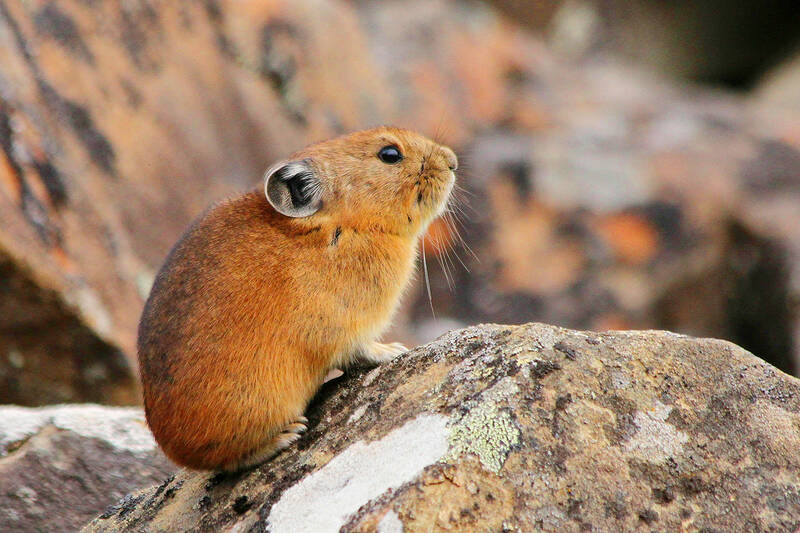With their round bodies, big ears, and cute name, pikas are often called the “real-life Pikachu.” Though often mistaken for rodents, pikas are actually close relatives of rabbits and hares. Pikas typically grow about to 20cm in length, with short limbs and no visible tail. They live in high-altitude regions across North America and Asia, where freezing temperatures and rocks define their world. Luckily, their dense fur helps them survive the cold in these extreme environments.
Pikas are known for their calls, which sound surprisingly loud for their size. Their calls resemble the high-pitched cry of a lamb, only much sharper and higher. These communications not only serve as warnings but also attract potential mates.
Beyond their vocal behavior, pikas impress scientists and nature-lovers with their lifestyle. Unlike hibernating animals, pikas remain active all year round. In summer, they collect and dry grasses, wildflowers and mosses as food to prepare for the harsh winter. This behavior ensures their survival and demonstrates their ability to adapt to environments with limited resources.

Photo: Freepik 照片:Freepik
Unfortunately, climate change is making life harder for pikas. With thick fur and high body temperatures, they cannot tolerate heat exceeding 25oC. As global warming intensifies, their cool habitats are shrinking. Human interference further compounds these challenges. On the Tibetan Plateau, large pika groups are seen as pests that eat grass meant for livestock. In response, the Chinese government has implemented large-scale poisoning campaigns to control their numbers. Many wildlife experts worry about the long-term ecological impact of this practice.
Although pikas as a whole are not classified as endangered, many local populations are quietly disappearing, such as the Ili pika. Their story reminds us that species loss often begins without notice. Protecting them means acting before decline turns into disappearance. In doing so, we also preserve the delicate mountain habitats they live in.
鼠兔有著圓滾滾的身體、大大的耳朵和可愛的名字,常被稱為「真實版的皮卡丘」。雖然經常被誤認為是囓齒動物,但鼠兔實際上是兔子和野兔的近親。鼠兔的體長大約可達20公分,四肢短小且沒有明顯的尾巴。牠們生活在北美和亞洲的高海拔地區,那裡嚴寒的氣溫和岩石構成了牠們的世界。幸運的是,濃密的皮毛幫助牠們在極端環境中抵禦寒冷並生存下來。
鼠兔以其叫聲而聞名,相對於牠們的體型來說,叫聲響亮得令人驚訝。牠們的叫聲類似於小羊的尖銳叫聲,只是更銳利、更高亢。這些叫聲不僅可作為警告,還能吸引潛在的配偶。
除了聲音行為之外,鼠兔的生活方式也讓科學家和大自然愛好者印象深刻。和會冬眠的動物不同,鼠兔全年都很活躍。在夏季,牠們會採集並曬乾草、野花和苔蘚,作為寒冬時的糧食。這種行為確保了牠們的生存,也展現了牠們適應資源有限環境的能力。
不幸的是,氣候變遷正讓鼠兔的生存變得更加艱難。由於擁有厚實的皮毛和較高的體溫,牠們無法忍受超過攝氏 25 度的氣溫。隨著全球暖化加劇,牠們涼爽的棲息地正在縮小。人類的干預更使問題雪上加霜。在青藏高原,大群鼠兔被視為有害的動物,因為牠們會搶吃原本要留給牲畜食用的草。為此,中國政府實施了大規模的毒殺活動,以控制鼠兔的數量。許多野生動物專家擔心這樣的做法對生態環境的長期影響。
雖然鼠兔整體而言並未被列為瀕臨絕種的,但許多當地族群正在悄悄消失,例如伊犁鼠兔。牠們的故事提醒我們,物種滅絕往往在不知不覺中開始。保護牠們意味著在數量下降演變成滅絕之前採取行動。這樣做,我們也是在守護牠們賴以生存的脆弱山區棲息地。
MORE INFORMATION
rodent n. 嚙齒動物
hare n. 野兔
high-altitude adj. 高海拔的
hibernate vi. 冬眠
moss n. 苔蘚
Tibetan Plateau 青藏高原
livestock n. 牲畜;家畜
KEY VOCABULARY
1. resemble vt. 與……相像;類似
The red panda got its name because it resembles the giant panda, but it’s actually more closely related to the raccoon.
紅熊貓的名字由來是因為牠像大熊貓,但實際上牠與浣熊的關係更為密切。
2. demonstrate v. 顯示;證明;示範
Belle’s success on the soccer team demonstrated to her school that boys and girls could play together safely.
貝兒在足球隊的成功向她的學校證明,男孩和女孩可以安全地一起比賽。
3. unfortunately adv. 不幸地
Unfortunately, Thomas won’t be able to make it to the meeting; his train has been delayed.
不幸地,湯瑪斯不能趕上開會;他搭的火車誤點了。
4. tolerate vt. 容忍;寬容
Wayne tolerated his neighbor’s noisy parties for months before he decided to complain.
韋恩忍受了鄰居吵鬧的聚會好幾個月,然後才決定投訴。
5. exceed v. 超過;勝過
Our CEO is pleased because we’ve exceeded our projected profits for this quarter.
我們的執行長很高興,因為我們這一季的獲利超出了預期。
6. intensify v. 加劇;強化
The music intensified the sad scene in the movie.
配樂增強了這部電影裡的悲傷場景。
7. pest n. 有害的動物;害蟲
It’s important to get rid of trash quickly, or else you’ll have lots of pests around.
迅速倒掉垃圾很重要,否則你周圍將有很多害蟲。
8. endangered adj. 瀕臨絕種的;遭遇危險的
Tigers, elephants and whales are all endangered animals at risk of dying out.
老虎、大象與鯨魚全都是有滅絕危機的瀕臨絕種的動物。
9. decline n. 衰退;衰落
The rise of e-books has caused a decline in regular book sales.
電子書的興起已造成了傳統書籍的銷售量下跌。
學習音檔: https://magazine.english4u.net/Magdata/menu/av87q
《空中美語》雜誌APP免費下載: https://www.english4u.net/apps/index.aspx
免費收聽當月《空中美語》雜誌課文朗讀及解析 !
文章由AMC空中美語授權使用: https://www.english4u.net

A: Hey, the world’s major dictionaries just unveiled their words of the year for 2025. B: Yup, the Cambridge Dictionary chose the word “parasocial,” which refers to a connection that someone feels between themselves and a famous person they don’t really know. A: One-sided parasocial relationships with celebrities, influencers and even AI chatbots have clearly become more common. B: The Oxford Dictionary picked “rage bait” — online content designed to elicit anger by being frustrating, provocative or offensive in order to increase traffic to Web sites or social media accounts. A: The Collins Dictionary picked “vibe coding.” Let’s

A: Apart from the world’s major dictionaries, the online Dictionary.com actually picked “67” as its word of the year. B: What does “67” even mean? A: Even the dictionary wasn’t exactly sure about its meaning. The slang term’s origin might be traced to US rapper Skrilla’s song Doot Doot (67). Aren’t Taiwanese media outlets choosing the Mandarin word for 2025? B: Yeah and after hearing the song Good-for-Nothing, adapted from some catchphrases of Legislator Wang Shih-chien, I’m going to vote for the character “tsung” (hasty) from the lyrics. A: Hopefully, in the new year, we’ll be calm as the

Sea star wasting disease (SSWD) is a strange and serious illness affecting sea stars, or starfish. This disease causes sea stars to develop painful lesions, lose their arms, and eventually turn into a gooey, melted mess. Since it was first observed in 2013, millions of sea stars along the Pacific coast of North America have died from this __1__. Although viruses were once considered a possible cause, researchers now believe that environmental stressors and microorganisms are primarily __2__ for sea star wasting disease. One of the main environmental triggers appears to be warmer ocean water. When the water heats

For many people in Taiwan, childhood memories of rural life include pig pens standing beside family homes. Leftover rice, vegetable scraps and soup from daily meals were poured into buckets and fed to pigs. This practice of feeding pigs with household food waste was once a common way of life, both an economic choice and an expression of agricultural society’s deep respect for conserving resources. From a practical standpoint, pigs are omnivorous animals capable of efficiently digesting food scraps that humans can no longer eat. For rural households, food waste cost almost nothing, yet it could be converted into pork, a